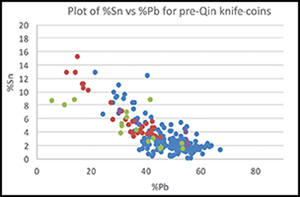Article contents
The six recipes of Zhou: a new perspective on Jin (金) and Xi (锡)
Published online by Cambridge University Press: 10 August 2022
Abstract

Knowledge of alloying practices is key to understanding the mass production of ancient Chinese bronzes. The Eastern Zhou text, the Rites of Zhou, contains six formulae, or recipes, for casting different forms of bronze based on the combination of two components: Jin and Xi. For more than 100 years, the precise interpretation of these two components has eluded explanation. Drawing on analyses of pre-Qin coinage, the authors offer a new interpretation, arguing that, rather than pure metals, Jin and Xi were pre-prepared copper-rich alloys, in turn indicating an additional step in the manufacturing process of copper-alloy objects. This result will be of interest to linguists, as well as archaeologists of ancient Chinese technology.
- Type
- Research Article
- Information
- Copyright
- Copyright © The Author(s), 2022. Published by Cambridge University Press on behalf of Antiquity Publications Ltd.
References
- 9
- Cited by


